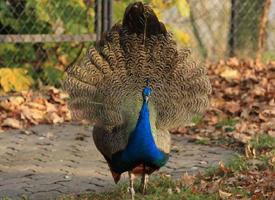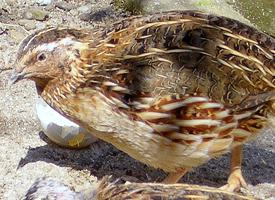
Descrierea animalului
The Indian Peafowl, scientifically known as Pavo cristatus, is a stunningly beautiful bird native to the Indian subcontinent, captivating observers with its brilliant plumage and majestic presence. Belonging to the family Phasianidae, which includes pheasants, grouse, and turkeys, the Indian Peafowl is most renowned for the male's extravagant display feathers, which have fascinated humans for centuries and played a significant role in various cultures and religions.Physically, the Indian Peafowl is a large and robust bird, with males, known as peacocks, and females, known as peahens, exhibiting notable sexual dimorphism. The peacock is famous for its dazzling tail feathers, or "train," which can span up to 60% of its total body length. These iridescent tail feathers are adorned with eye-like patterns, known as ocelli, that shimmer in hues of blue, green, and gold, creating a mesmerizing spectacle when fanned out in a courtship display or defensive posture. This dramatic train is not the tail itself but elongated upper tail coverts. The actual tail feathers are shorter and help support the train during display. The peacock's body is also a work of art, with a deep blue head, neck, and breast, while the lower body is a contrasting white. A crest of feathered tips adorns the top of the head, adding to its regal appearance.
In contrast, the peahen is more subdued in coloration, sporting a mixture of muted green, brown, and grey, which helps camouflage her in the forest underbrush, especially when nesting. This coloration strategy is crucial for protecting the eggs and young from predators. Despite her lack of the peacock's flamboyant tail, the peahen possesses a subtle beauty, with a crest of feathers and a white underbelly.
Indian Peafowls are ground-dwelling birds, although they roost in trees. They are omnivores, feeding on a diverse diet that includes seeds, fruits, insects, and small vertebrates. This adaptability in feeding habits has allowed them to thrive in various habitats, from dense forests to cultivated areas and even urban outskirts.
Their call is another distinctive feature; the loud, piercing "may-awe" of the peacock can be heard over long distances, serving as a means of communication between birds, especially during the breeding season. Peafowls are generally gregarious birds, living in small groups, though males can be solitary or form bachelor groups outside the breeding season.
Breeding season is a spectacle to behold, as peacocks fan out their magnificent trains and perform elaborate dances to attract peahens. The peahen selects her mate based on the size, color, and quality of the male's display, an example of sexual selection at work. After mating, the peahen lays a clutch of eggs, usually 4 to 8, which she incubates for about 28 days until they hatch.
The Indian Peafowl has a long association with human culture, symbolizing grace, beauty, and the divine in various religions and mythologies. It is the national bird of India, emblematic of the country's rich biodiversity and cultural heritage. Despite facing threats from habitat loss and hunting in some areas, the Indian Peafowl is classified as Least Concern by the International Union for Conservation of Nature (IUCN), owing to its wide range and large, stable population. Conservation efforts continue to ensure that this magnificent bird graces the landscapes of the Indian subcontinent for generations to come.
Animale similare
Fotografii noi cu animale
Top 10 animale
- Dolphin gull (Leucophaeus scoresbii)
- Diana monkey (Cercopithecus diana)
- Moustached guenon (Cercopithecus cephus)
- Greek tortoise (Testudo graeca)
- Stone loach (Barbatula barbatula)
- Galápagos tortoise (Geochelone nigra complex)
- Japanese macaque (Macaca fuscata)
- Russian tortoise (Testudo horsfieldii)
- Common flying dragon (Draco volans)
- Galápagos penguin (Spheniscus mendiculus)


